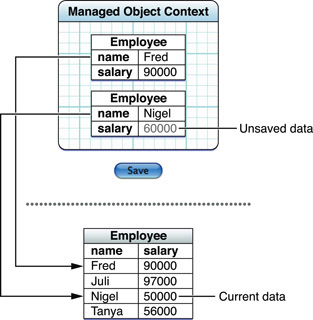Retired Document
Important: This document may not represent best practices for current development. Links to downloads and other resources may no longer be valid.
Managed object context
A managed object context represents a single object space, or scratch pad, in a Core Data application. A managed object context is an instance of NSManagedObjectContext. Its primary responsibility is to manage a collection of managed objects. These managed objects represent an internally consistent view of one or more persistent stores. The context is a powerful object with a central role in the life-cycle of managed objects, with responsibilities from life-cycle management (including faulting) to validation, inverse relationship handling, and undo/redo.
From your perspective, the context is the central object in the Core Data stack. It’s the object you use to create and fetch managed objects, and to manage undo and redo operations. Within a given context, there is at most one managed object to represent any given record in a persistent store.

A context is connected to a parent object store. This is usually a persistent store coordinator, but may be another managed object context. When you fetch objects, the context asks its parent object store to return those objects that match the fetch request. Changes that you make to managed objects are not committed to the parent store until you save the context.
In some applications, you may have just a single context. In others, however, you might have more than one. You might want to maintain discrete sets of managed objects and edits to those objects; or you might want to perform a background operation using one context while allowing the user to interact with objects in another.
Copyright © 2018 Apple Inc. All Rights Reserved. Terms of Use | Privacy Policy | Updated: 2018-04-06